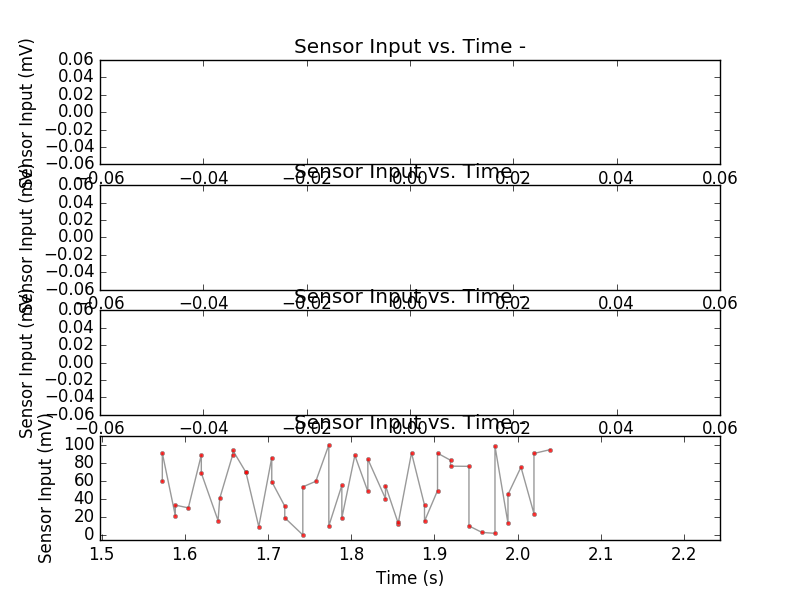blit with subgraph draws only the last subgraph
I’m trying to plot multiple subgraphs in real time in my python application. Ideally, I should also be able to draw multiple lines in each subgraph, but for simplicity, I’m assuming that one line is drawn in each subgraph.
To do this effectively (I’m looking for quick drawings), I’m trying to combine an example I found online (https://taher-zadeh.com/speeding-matplotlib-plotting-times-real-time-monitoring-purposes/ ) extends to my case. My code is:
import time
# for Mac OSX
import matplotlib
matplotlib.use('TkAgg')
import matplotlib.pylab as plt
import random
def test_fps(use_blit=True):
ax1.cla()
ax1.set_title('Sensor Input vs. Time -')
ax1.set_xlabel('Time (s)')
ax1.set_ylabel('Sensor Input (mV)')
ax2.cla()
ax2.set_title('Sensor Input vs. Time -' )
ax2.set_xlabel('Time (s)')
ax2.set_ylabel('Sensor Input (mV)')
ax3.cla()
ax3.set_title('Sensor Input vs. Time -')
ax3.set_xlabel('Time (s)')
ax3.set_ylabel('Sensor Input (mV)')
ax4.cla()
ax4.set_title('Sensor Input vs. Time -')
ax4.set_xlabel('Time (s)')
ax4.set_ylabel('Sensor Input (mV)')
plt.ion() # Set interactive mode ON, so matplotlib will not be blocking the window
plt.show(False) # Set to false so that the code doesn't stop here
cur_time = time.time()
ax1.hold(True)
ax2.hold(True)
ax3.hold(True)
ax4.hold(True)
x, y = [], []
times = [time.time() - cur_time] # Create blank array to hold time values
y.append(0)
line1, = ax1.plot(times, y, '.-', alpha=0.8, color="gray", markerfacecolor="red")
line2, = ax2.plot(times, y, '.-', alpha=0.8, color="gray", markerfacecolor="red")
line3, = ax3.plot(times, y, '.-', alpha=0.8, color="gray", markerfacecolor="red")
line4, = ax4.plot(times, y, '.-', alpha=0.8, color="gray", markerfacecolor="red")
fig.show()
fig.canvas.draw()
if use_blit:
background1 = fig.canvas.copy_from_bbox(ax1.bbox) # cache the background
background2 = fig.canvas.copy_from_bbox(ax2.bbox) # cache the background
background3 = fig.canvas.copy_from_bbox(ax3.bbox) # cache the background
background4 = fig.canvas.copy_from_bbox(ax4.bbox) # cache the background
tic = time.time()
niter = 200
i = 0
while i < niter:
fields = random.random() * 100
times.append(time.time() - cur_time)
y.append(fields)
# this removes the tail of the data so you can run for long hours. You can cache this
# and store it in a pickle variable in parallel.
if len(times) > 50:
del y[0]
del times[0]
xmin, xmax, ymin, ymax = [min(times) / 1.05, max(times) * 1.1, -5,110]
# feed the new data to the plot and set the axis limits again
plt.axis([xmin, xmax, ymin, ymax])
if use_blit:
fig.canvas.restore_region(background1) # restore background
line1.set_xdata(times)
line1.set_ydata(y)
ax1.draw_artist(line1) # redraw just the points
fig.canvas.blit(ax1.bbox) # fill in the axes rectangle
fig.canvas.restore_region(background2) # restore background
line2.set_xdata(times)
line2.set_ydata(y)
ax2.draw_artist(line2) # redraw just the points
fig.canvas.blit(ax2.bbox)
fig.canvas.restore_region(background3) # restore background
line3.set_xdata(times)
line3.set_ydata(y)
ax3.draw_artist(line3) # redraw just the points
fig.canvas.blit(ax3.bbox)
fig.canvas.restore_region(background4) # restore background
line4.set_xdata(times)
line4.set_ydata(y)
ax4.draw_artist(line4) # redraw just the points
fig.canvas.blit(ax4.bbox)
else:
fig.canvas.draw()
fig.canvas.flush_events()
i += 1
fps = niter / (time.time() - tic)
return fps
and
fig = plt.figure()
ax1 = fig.add_subplot(4, 1, 1)
ax2 = fig.add_subplot(4, 1, 2)
ax3 = fig.add_subplot(4, 1, 3)
ax4 = fig.add_subplot(4, 1, 4)
fps1 = test_fps(use_blit=True)
The problem with this code is that it only draws to the last subgraph, leaving the other subgraphs blank.
I’m new to python and I guess it’s a pretty stupid question, but I haven’t figured it out yet, so every hint would be helpful to me.
Thanks
Solution
In the current implementation, you set the axis limit only for the last graph, i.e. plt.axis([xmin, xmax, ymin, ymax]) applies to the last event subgraph.
Instead, you need to update all axes ax1 to ax4
ax1.axis([xmin, xmax, ymin, ymax])
ax2.axis([xmin, xmax, ymin, ymax])
ax3.axis([xmin, xmax, ymin, ymax])
ax4.axis([xmin, xmax, ymin, ymax])
Let their limits follow the data.
Also, it seems beneficial to update the data outside of the blitting condition so that people can compare blitting without blitting.
Full code:
import time
import matplotlib
matplotlib.use('TkAgg')
import matplotlib.pylab as plt
import random
def test_fps(use_blit=True):
ax1.cla()
ax1.set_title('Sensor Input vs. Time -')
ax1.set_xlabel('Time (s)')
ax1.set_ylabel('Sensor Input (mV)')
ax2.cla()
ax2.set_title('Sensor Input vs. Time -' )
ax2.set_xlabel('Time (s)')
ax2.set_ylabel('Sensor Input (mV)')
ax3.cla()
ax3.set_title('Sensor Input vs. Time -')
ax3.set_xlabel('Time (s)')
ax3.set_ylabel('Sensor Input (mV)')
ax4.cla()
ax4.set_title('Sensor Input vs. Time -')
ax4.set_xlabel('Time (s)')
ax4.set_ylabel('Sensor Input (mV)')
plt.ion() # Set interactive mode ON, so matplotlib will not be blocking the window
plt.show(False) # Set to false so that the code doesn't stop here
cur_time = time.time()
# ax1.hold(True)
# ax2.hold(True)
# ax3.hold(True)
# ax4.hold(True)
x, y = [], []
times = [time.time() - cur_time] # Create blank array to hold time values
y.append(0)
line1, = ax1.plot(times, y, '.-', alpha=0.8, color="gray", markerfacecolor="red")
line2, = ax2.plot(times, y, '.-', alpha=0.8, color="gray", markerfacecolor="red")
line3, = ax3.plot(times, y, '.-', alpha=0.8, color="gray", markerfacecolor="red")
line4, = ax4.plot(times, y, '.-', alpha=0.8, color="gray", markerfacecolor="red")
fig.show()
fig.canvas.draw()
if use_blit:
background1 = fig.canvas.copy_from_bbox(ax1.bbox) # cache the background
background2 = fig.canvas.copy_from_bbox(ax2.bbox) # cache the background
background3 = fig.canvas.copy_from_bbox(ax3.bbox) # cache the background
background4 = fig.canvas.copy_from_bbox(ax4.bbox) # cache the background
tic = time.time()
niter = 200
i = 0
while i < niter:
fields = random.random() * 100
times.append(time.time() - cur_time)
y.append(fields)
# this removes the tail of the data so you can run for long hours. You can cache this
# and store it in a pickle variable in parallel.
if len(times) > 50:
del y[0]
del times[0]
xmin, xmax, ymin, ymax = [min(times) / 1.05, max(times) * 1.1, -5,110]
# feed the new data to the plot and set the axis limits again
ax1.axis([xmin, xmax, ymin, ymax])
ax2.axis([xmin, xmax, ymin, ymax])
ax3.axis([xmin, xmax, ymin, ymax])
ax4.axis([xmin, xmax, ymin, ymax])
line1.set_data(times, y)
line2.set_data(times, y)
line3.set_data(times, y)
line4.set_data(times, y)
if use_blit:
fig.canvas.restore_region(background1) # restore background
ax1.draw_artist(line1) # redraw just the points
fig.canvas.blit(ax1.bbox) # fill in the axes rectangle
fig.canvas.restore_region(background2) # restore background
ax2.draw_artist(line2) # redraw just the points
fig.canvas.blit(ax2.bbox)
fig.canvas.restore_region(background3) # restore background
ax3.draw_artist(line3) # redraw just the points
fig.canvas.blit(ax3.bbox)
fig.canvas.restore_region(background4) # restore background
ax4.draw_artist(line4) # redraw just the points
fig.canvas.blit(ax4.bbox)
else:
fig.canvas.draw()
fig.canvas.flush_events()
i += 1
fps = niter / (time.time() - tic)
return fps
fig = plt.figure()
ax1 = fig.add_subplot(4, 1, 1)
ax2 = fig.add_subplot(4, 1, 2)
ax3 = fig.add_subplot(4, 1, 3)
ax4 = fig.add_subplot(4, 1, 4)
fps1 = test_fps(use_blit=True)
print fps1
Note that this didn’t run at 10fps blitting and 16fps blitting when running on my computer.

